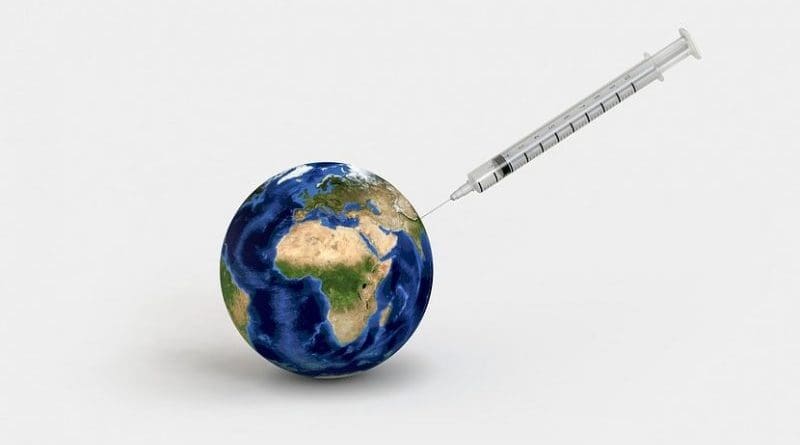Pneumonia The Number One Killer Disease Of Children
By IDN
By Sean Buchanan
Pneumonia, an entirely preventable disease, claimed the lives of 800,000 children – or one child every 39 seconds – under the age of five last year, but funding to improve survival rates continues to lag, according to a new analysis.
Most deaths occurred among children under the age of two, and almost 153,000 within the first month of life, says a UN Children’s Fund (UNICEF) analysis produced in September 2019, based on estimates from the World Health Organisation (WHO), the Maternal and Child Epidemiology Estimation Group (MCEE) and the United Nations Inter-agency Group for Child Mortality Estimation.
Sounding the alarm about this forgotten epidemic, six leading health and children’s organisations – ISGlobal, Save the Children, UNICEF, Every Breath Counts, Unitaid and Gavi, the Vaccine Alliance – launched an appeal on November 12 for global action.
Calling for concrete commitments from high-burden countries and international donors to tackle pneumonia, the group – together with the “la Caixa” Foundation, the Bill and Melinda Gates Foundation and USAID – will host the Global Forum on Childhood Pneumonia in Spain on January 29-31, 2020.
Henrietta Fore, Executive Director of UNICEF, said: “Every day, nearly 2,200 children under the age of five die from pneumonia, a curable and mostly preventable disease. Strong global commitment and increased investments are critical to the fight against this disease. Only through cost-effective protective, preventative and treatment interventions delivered to where children are will we be able to truly save millions of lives.”
Pneumonia is caused by bacteria, viruses or fungi, and leaves children fighting for breath as their lungs fill with pus and fluid.
More children under the age of five died from the disease in 2018 than from any other. 437,000 children under five died due to diarrhoea and 272,000 to malaria.
Kevin Watkins, Chief Executive of Save the Children, said: “This is a forgotten global epidemic that demands an urgent international response. Millions of children are dying for want of vaccines, affordable antibiotics, and routine oxygen treatment. The pneumonia crisis is a symptom of neglect and indefensible inequalities in access to health care.”
Just five countries were responsible for more than half of child pneumonia deaths: Nigeria (162,000), India (127,000), Pakistan (58,000), the Democratic Republic of Congo (40,000) and Ethiopia (32,000).
Children with immune systems weakened by other infections like HIV or by malnutrition, and those living in areas with high levels of air pollution and unsafe water, are at far greater risk.
The disease can be prevented with vaccines, and easily treated with low-cost antibiotics if properly diagnosed.
But tens of millions of children are still going unvaccinated – and one in three with symptoms do not receive essential medical care.
In 2018, 71 million children did not receive the recommended three doses of pneumococcal conjugate vaccine (PCV), putting them at higher risk of pneumonia. Globally, 32 percent of children with suspected pneumonia are not taken to a health facility. That figure rises to 40 percent for the poorest children in low- and middle-income countries.
Children with severe cases of pneumonia may also require oxygen treatment, which is rarely available in the poorest countries for the children who need it.
Dr Seth Berkley, CEO of Gavi, the Vaccine Alliance, said: “The fact that this preventable, treatable and easily diagnosed disease is still the world’s biggest killer of young children is frankly shocking. We have made strong progress over the last decade, with millions of children in the world’s poorest countries now receiving the lifesaving pneumococcal vaccine. Thanks largely to Gavi’s support, pneumococcal vaccine coverage in low-income countries is now higher than the global average, but we still have work to do to ensure every child has access to this lifesaver.”
Funding available to tackle pneumonia lags far behind other diseases. Only three percent of current global infectious disease research spending is allocated to pneumonia, despite the disease causing 15 percent of deaths in children under the age of five.
According to Leith Greenslade, Coordinator of Every Breath Counts, “for decades the leading killer of children has been a neglected disease and the world’s most vulnerable children have paid the price. It’s time for governments, UN and multilateral agencies, companies and NGOs to join forces to fight pneumonia and protect these children.”
In a joint call to action, the organisations urge governments in the worst-affected countries to develop and implement Pneumonia Control Strategies to reduce child pneumonia deaths; and to improve access to primary health care as part of a wider strategy for universal health coverage.
They also call on richer countries, international donors and private sector companies to boost immunisation coverage by reducing the cost of key vaccines and ensuring the successful replenishment of Gavi, the Vaccine Alliance, as well as increase funding for research and innovation to tackle the disease.

